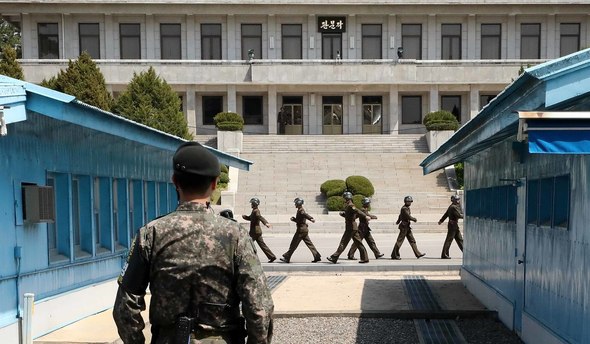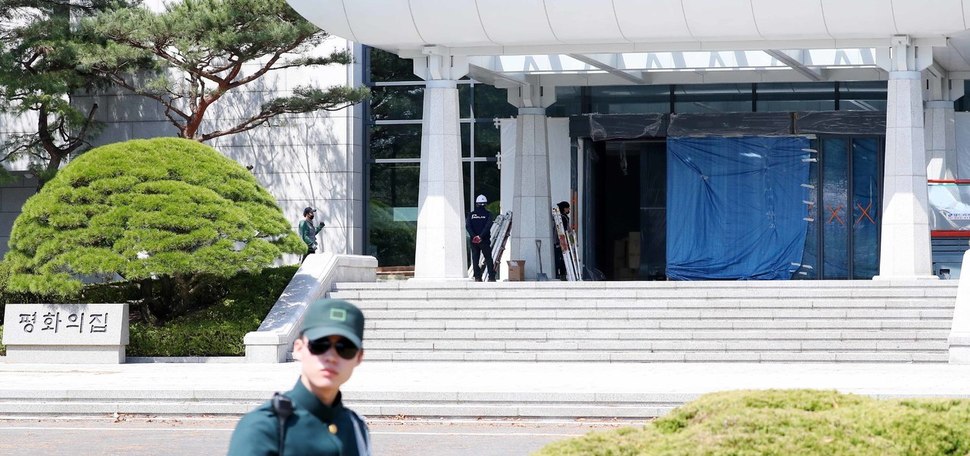 |
|
How will the two leaders met at the inter-Korean summit?
|
The inter-Korean summit will take place at the Peace House on Apr. 27
It was a warm spring day as those of us in the Blue House press corps headed for Panmunjeom on April 18. The white blossoms of the cherry trees had already burst forth in the relaxing sunshine. In the Demilitarized Zone (DMZ) south of the Military Demarcation Line (MDL), dandelions bloomed along the ridges between the rice paddies farmed by the residents of the Daeseong-dong Freedom Village. The access road that leads into the Joint Security Area (JSA), where Panmunjeom is located, is part of Route 1. The road begins in Mokpo, South Jeolla Province, and passes through Seoul, Gaesong, and Pyongyang on its way to its terminus in Sinuiju. But beyond Panmunjeom we cannot go. Our bus, which left from Camp Bonifas, a military post shared by the ROK military and the United States Forces Korea, covered the 2.4-km distance to Panmunjeom in just under ten minutes. The camp was named after Captain Arthur G. Bonifas, who was killed by North Korean soldiers in the Axe Murder Incident of 1976. President Moon Jae-in has a connection with this incident. He was in the service at the time, and his airborne unit was assigned to cut down the eastern cottonwood trees that blocked the view from the south checkpoint in Panmunjeom. The dominant color at Panmunjeom is sky blue. Here and there are signs in this symbolic color of the United Nations Command. The buildings that stand right on the Demarcation Line and house the meeting room of the Neutral Nations Supervisory Commission and the main and small meeting rooms of the Military Armistice Commission are also painted sky blue. Panmunjeom is not very big. It measures only 800 meters from east to west and 400 meters from north to south. The layout is symmetrical, with Freedom House and Peace House standing to the south of the Demarcation Line and Panmun Pavillion on the north side. Panmunjeom's former name was Neolmun-ri (meaning "Wooden Door Village"). The JSA Visitor Center explains it this way: "A small, quiet village called Neolmun-ri originally stood at the site of Panmunjeom. During the Korean War, truce talks were held at Naebongjang, in Gaesong, but because of the danger of frequent combat nearby, the talks were moved to Neolmun-ri on September 6, 1951. In order to make it easier for representatives of the Chinese forces to find the place, they told them to look for the sign on a neighboring shop, which read Panmunjeom in Chinese characters. The pan character means 'wooden board,' mun means 'door,' and jeom means 'shop.'" Memories of the division between north and south and of the armistice negotiations live on at Panmunjeom. They began in tents set up here, and the meetings were held 765 times over a period of two years. Since the first North-South Red Cross talks in 1971, 365 meetings, large and small, have been held here. During our visit, the final stages of renovation work were going on at Peace House, where the summit will be held on Apr. 27. This is about 300 meters from the MDL and only about 200 meters from the place where the North Korean soldier Oh Cheong-seong was shot while fleeing to South Korea in November 2017. A temporary blue screen blocks the main entrance of the building. With only two or three workers on the site, the construction appears to be almost finished.
 |
|
A South Korean soldier watches North Korean soldiers march in formation on the other side of the MDL at Panmunjeom on Apr. 18. (Blue House Photo Pool)
|
 |
|
Renovation work is going on at Peace House on the South Korean side of the Panmunjeom JSA, where the inter-Korean summit meeting will be held on April 27. (by Kim Kyung-ho, staff reporter)
|







